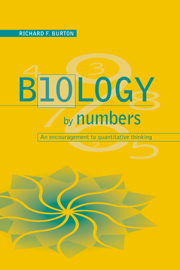Book contents
- Frontmatter
- Contents
- Preface
- A guide to the book
- 1 Putting two and two together
- 2 Units, formulae and the use of old envelopes: confronting some obstacles to quantitative thinking
- 3 Aspects of energy metabolism
- 4 Getting things in proportion
- 5 Perilous percentages, dangerous ratios
- 6 Building a trophic pyramid
- 7 Sodium in animals and plants
- 8 Exchanges of water and carbon dioxide
- 9 A geometric series
- 10 Introduction to logarithms
- 11 Bringing logarithms to life
- 12 Exponential relationships
- 13 Aspects of allometry
- 14 More on allometry, and on quantitative patterns in nature
- 15 How the abundance of food affects rates of feeding
- 16 The characterization of trees and other branching systems
- 17 Epilogue
- References
- Notes
- Index
A guide to the book
Published online by Cambridge University Press: 05 June 2012
- Frontmatter
- Contents
- Preface
- A guide to the book
- 1 Putting two and two together
- 2 Units, formulae and the use of old envelopes: confronting some obstacles to quantitative thinking
- 3 Aspects of energy metabolism
- 4 Getting things in proportion
- 5 Perilous percentages, dangerous ratios
- 6 Building a trophic pyramid
- 7 Sodium in animals and plants
- 8 Exchanges of water and carbon dioxide
- 9 A geometric series
- 10 Introduction to logarithms
- 11 Bringing logarithms to life
- 12 Exponential relationships
- 13 Aspects of allometry
- 14 More on allometry, and on quantitative patterns in nature
- 15 How the abundance of food affects rates of feeding
- 16 The characterization of trees and other branching systems
- 17 Epilogue
- References
- Notes
- Index
Summary
The Preface explains what this book is and is not about, but it may be helpful to provide a quick sketch map of it here and to offer suggestions for its use.
Chapter 1 makes general points about the application of simple arithmetic to biology, and Chapter 2 is intended to help counter possible obstacles to further progress. Chapters 3 to 8 touch on various biological topics, with the emphasis again on simple arithmetic; here there is some ordering of subjects along conventional biological lines, but rather more in terms of particular kinds of logical or arithmetical argument. Concepts of energy are important in biology, from physiology to ecology, and appear in all of Chapters 3 to 8. Chapter 9 initiates a progression away from everyday arithmetic, through the geometric series of repeated doublings, to logarithms, and so to exponential relationships in Chapter 12. Chapters 13 and 14 together constitute a distinct section on the importance of size and scale to biology and may also be characterized as dealing with relationships involving powers and logarithms. Chapter 15, overtly about feeding rates, serves to indicate approaches to quantitative biology that are otherwise neglected. Chapter 16 is about coping quantitatively with trees and other branching systems. The Epilogue then brings together various loose ends in a final knot. Notes at the end of the book elaborate on parts of the text and suggest references for further reading.
- Type
- Chapter
- Information
- Biology by NumbersAn Encouragement to Quantitative Thinking, pp. xv - xviPublisher: Cambridge University PressPrint publication year: 1998



